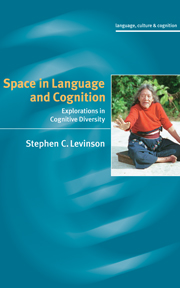Book contents
- Frontmatter
- Contents
- List of figures
- List of tables
- Preface
- Acknowledgements
- 1 The intellectual background: two millennia of Western ideas about spatial thinking
- 2 Frames of reference
- 3 Linguistic diversity
- 4 Absolute minds: glimpses into two cultures
- 5 Diversity in mind: methods and results from a cross-linguistic sample
- 6 Beyond language: frames of reference in wayfinding and pointing
- 7 Language and thought
- Notes
- List of references
- Language index
- Author index
- Subject index
6 - Beyond language: frames of reference in wayfinding and pointing
Published online by Cambridge University Press: 03 December 2009
- Frontmatter
- Contents
- List of figures
- List of tables
- Preface
- Acknowledgements
- 1 The intellectual background: two millennia of Western ideas about spatial thinking
- 2 Frames of reference
- 3 Linguistic diversity
- 4 Absolute minds: glimpses into two cultures
- 5 Diversity in mind: methods and results from a cross-linguistic sample
- 6 Beyond language: frames of reference in wayfinding and pointing
- 7 Language and thought
- Notes
- List of references
- Language index
- Author index
- Subject index
Summary
In the prior chapters, we have seen that language, together with other semiotic systems, seems to have a decisive impact on the choice of an internal code for spatial memory and reckoning. In this chapter, we explore other possible ramifications of frame-of-reference specialization. The literature reviewed in Chapter 2 suggests that there are a myriad of internal representations of space for different sensory modalities and purposes. If language can be shown to influence the choice of frame of reference for the spatial memory of small-scale arrays, what about larger-scale arrays and mental models of the world around us? After all, spatial cognition must centrally be concerned with locating ourselves in a ‘mental map’ of the environment, and finding our way around in it. This chapter pursues differences in the cognition of wayfinding and orientation that seem deeply linked to specializations in frames of reference in language. But the chapter also pursues another theme, the cross-modal nature of these frame-of-reference specializations. For the best evidence for wayfinding abilities and the nature of mental maps comes from pointing and gesture – that is from the motoric output driven (at least proximately) by kinaesthetic representations. Unreflective gesture gives us insight into another level of mental life, representations of space that are at least partially independent of language, and that seem close to the very heart of our spatial thinking and spatial imagery. We can therefore look at gesture as a special window on underlying spatial cognition.
- Type
- Chapter
- Information
- Space in Language and CognitionExplorations in Cognitive Diversity, pp. 216 - 279Publisher: Cambridge University PressPrint publication year: 2003



